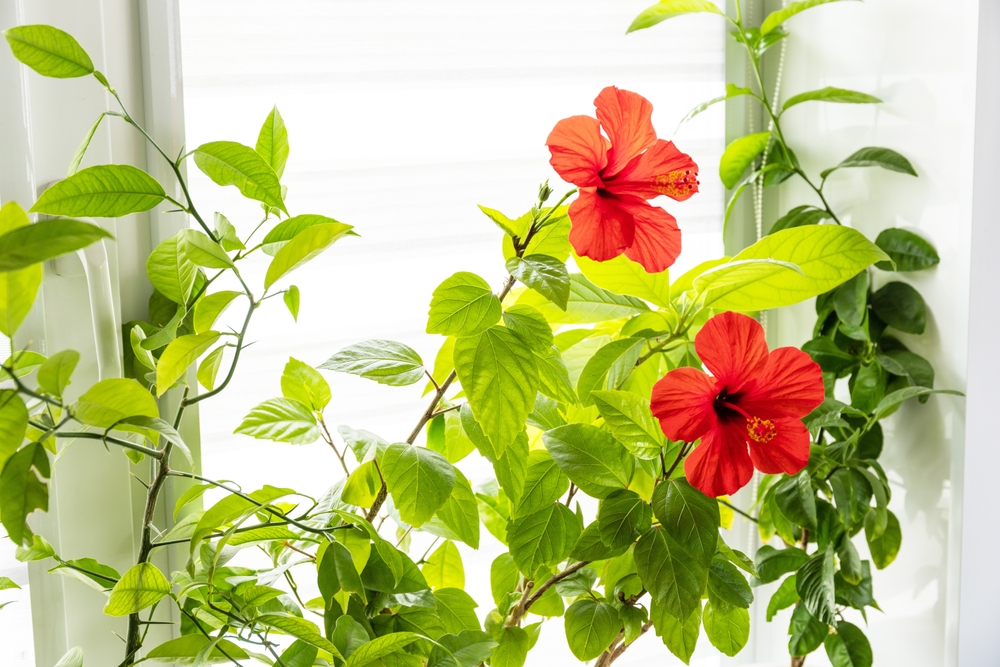Introduction
Hibiscus, also known as hibiscus rosa sinensis, is a flowering plant that is both visually appealing and medicinal. Though simple to grow, these plants require attention to thrive. Check out some simple hibiscus growing and care tips.
Hibiscus, scientifically known as Hibiscus rosa sinensis, is a genus of flowering plants with several hundred species found in tropical and subtropical regions around the world. The colourful flowering plant is also widely used to make supplements, extracts, and teas. Consuming this plant can lower blood pressure, cholesterol, and improve liver health.
Hibiscus plants, which are commonly referred to as easy creepers, are easy to grow throughout India. However, it is critical to understand what steps to take before sowing the seeds. This ensures that your plant not only survives, but thrives. Here is a step-by-step guide to growing hibiscus plants at home, as well as tips for easy care and maintenance.
Types Of Hibiscus Plants
Hibiscus plants are available in approximately 220 species around the world, each with unique characteristics and appearances. Before you sow the seeds, make sure you have the right type of hibiscus. When making a decision, consider the variety you want and the weather conditions that can support it.
Hibiscus plants are classified as either tropical or hardy. If you live in a hotter climate, select the tropical type. If your region experiences more winters, the hardy type will thrive.
The tropical hibiscus plant produces numerous blooms in purple, pink, and peach shades.
The hardy hibiscus plant is bushy and produces white, red, and pink hibiscus flowers.
Deciding When to Plant Hibiscus
The ideal time to plant hibiscus seeds is after the winter season has passed. You can start planting once the outdoor temperatures are consistently below 16 to 21 degrees Celsius. If the temperature drops below 16 degrees Celsius, your plant may die. On the other hand, the hardy hibiscus plant can tolerate lower temperatures but still requires some heat.
Maintain a temperature of 16 to 21 degrees Celsius for the hibiscus plant to grow.
Location of Hibiscus Plant
Hibiscus can live for more than 40 years, so they require a larger space to grow. Choose a permanent location in your home garden where you will be able to care for the plant for many years.
If the plant is exposed to direct sunlight for an extended period of time, it may die as a result of excessive heat. So, place the plant somewhere where it will receive only 4 to 6 hours of direct sunlight. Following that, only mild sunlight should reach the plant.
Type of Soil for Hibiscus
Hibiscus plants have specific soil requirements. Take the time to amend the soil so that it meets your plant’s needs. Test the pH of your garden soil, and if it is 6.5 or lower, make it more acidic. In addition, add fertilizer and nutrients to the soil to help your hibiscus plant grow faster.
Planting Your Hibiscus
To begin planting your hibiscus, dig holes about twice as deep as the roots would go. The loose soil around your hibiscus plant will improve drainage and should not be tamped down. Plant each seed two to three inches apart.
Dig holes deeper than normal when planting in cold climates.
When planting in warm climates, place the seeds closer to the soil surface.
Planting the hibiscus seeds requires proper strategy.
Watering Your Hibiscus Plants
Hibiscus plants thrive in moist soil, so avoid overwatering. Ensure that the soil is consistently moist but not wet. If the top layer of soil on your hibiscus plant has dried out, water it. Not watering the plant on time can cause the flowers to wilt and dry.Only water the plant when the soil becomes noticeably dry. The hibiscus plant must be watered in a balanced manner.
Fertilize your plant once per week during the blooming period.
Water the hibiscus plant when the top layer of soil is dry.
Hibiscus Pest and Weed Protection
It is advised that you give your hibiscus plant a layer of mulch. This method will retain moisture and keep weeds out. To prevent your plant from dispersing its nutrients to undesirable places, make sure you remove any weeds. A tropical variety you planted might experience pest problems more frequently than the others. To eradicate any pests or illnesses that might be endangering your hibiscus plant, you can apply organic insecticides.
How to Trim Your Hibiscus Plant
Pruning a plant in a timely manner encourages growth, which increases flower production. While there are numerous ways to prune the plant, cutting the branches just above the leaf joint is the most effective method. Your hibiscus plant will receive this as a signal to grow more branches nearby.
If any part of your hibiscus plant dies or becomes dry, you will need to correct your pruning. This will encourage the growth of more robust leaves.
Never prune a branch by removing more than two-thirds of it at a time. This will cause serious harm to the Hibiscus.
Crucial Maintenance Advice for Hibiscus Plants
While the steps outlined above are sufficient to ensure that your hibiscus plant not only grows but thrives, there are a few additional suggestions you may want to consider for better results. Here are professional tips for maintaining a hibiscus plant in your home garden:
Hibiscus is very susceptible to pests. Whiteflies, spider mites, and aphids are the most common visitors. To resolve this issue, apply fertiliser or pesticides.
Pruning your hibiscus plant once in the spring is essential for optimal growth.
If you notice the hibiscus leaves turning yellow, water them less. This is a common problem for indoor plants on colder days. Reduce watering because yellow leaves are early warning signs.
Avoid using clay pots for hibiscus plants. Clay can cause the soil to become more alkaline over time, which the plant does not prefer. For indoor growing, you can use a plastic container.
Why do Hibiscus Plant Leaves Turn Yellow?
One of the most common issues that hibiscus plants have is that their leaves turn yellow. Here are some of the most common reasons why Hibiscus leaves turn yellow.
Temperature Change: When the temperature changes, such as when it is extremely hot or cold, the humidity level changes, causing the leaves to yellow.
Pest or bug attack: Spider mites, mealy bugs, and aphids frequently attack the Hibiscus plant. The attack of these frequently causes the leaves to turn yellow.
Nutrient Deficiency: If your hibiscus plant does not receive adequate nutrients from the soil, the plant’s leaves will turn yellow.
Too Little or Too Much Water: If you do not water your hibiscus plant, its leaves may turn yellow in either situation: if the water is too much, it causes root rot; if the water is too little, it causes drying up.
Concluding Growing Hibiscus at Home
Growing hibiscus plants in your home garden is simple; however, they require constant care and attention to live a long life. The information provided above is all you need to grow Hibiscus at home and care for it properly. Before planting your Hibiscus, make sure you select the appropriate placement, type, and temperature conditions. Acidic soil promotes better plant growth, and regular watering can help it grow even more. A properly maintained and cared-for hibiscus plant can live for up to 40 years. As a result, carefully consider where you will plant your seeds, as the plant will require space and stability.
















